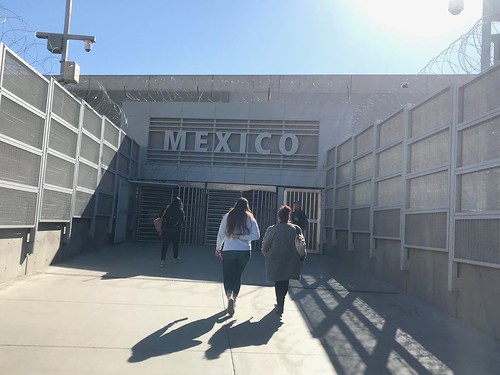
I spent this afternoon on a guided street food tour of Tijuana. Starting at the Blue Line trolley stop near my Airbnb, I took a ~45 minute ride to the last stop on the line at San Ysidro. The trolley stop is a stone’s throw from the border between the US and Mexico.
I’d signed up for the Wild Foodie Tours Tijuana street food tour based on many positive online reviews. As it turned out our guide Albert is the one man operation behind the company. He’s a self-described foodie who comes from a restaurant family.
The tour I’m about to describe is my experience only; this tour varies depending on what’s available on Tijuana’s street food scene. I should also point out I’ve commented on Mexico’s excellent street food scene before during my visit to Mexico City in 2011.
The tour started — ironically enough — just outside a McDonald’s at the border. You can’t miss the location if you take the trolley since it’s at the trolley platform. Albert guided us through Mexico’s customs. On foot it’s not super obvious where to go, but once you’re inside you get a passport stamp, they scan your bags, and that’s about it.
Aside from the guide our group included myself from California, two people from New Jersey, and a family from New Zealand. The last group took a little longer but I think the total time was probably under ten minutes. It’s not like the old days where people could apparently just walk into Mexico, but it’s still pretty fast.
On the other side of the border we walked over to a shared taxi stop. If you’re unfamiliar with Mexico’s transit this might be a little confusing. In American English we call a shared taxi a “jitney”, but I doubt many Americans are familiar with the term. It’s kind of like public transit in that it’s cheap and shared, but it’s not strictly official. Even if you speak Spanish I’d recommend a local guide for this mode of transit.
Our first stop was a semi-open air farmer’s market, Mercado M. Hidalgo. It’s a super crowded and not particularly tourist friendly market where you can find everything from fruits and vegetables to religious figurines and pinatas. I had to keep dodging people and ducking in order to follow our group around the place.
Early on our guide got a large fruta con chile to share for the group. This is a simple, classic Mexican snack: it’s a bunch of big wedges of fruit (melons, jicama, etc.) dusted with chili powder. The sweet juicy fruits combined with the spices combine in your mouth to explode with a strange sensation of burning sweetness.
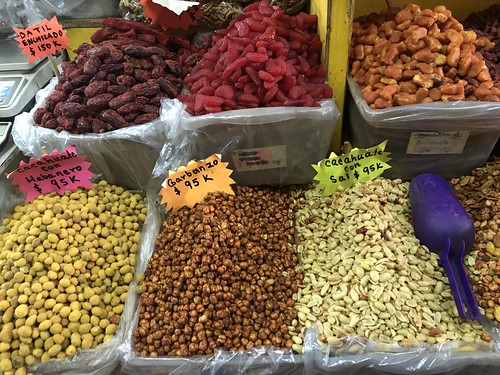
We stopped at the market to sample a variety of foods available for purchase, the highlight for me was a shop selling spiced nuts and dried fruits. I wish I’d bought some of the spiced peanuts but I also know I’d have wolfed them all down by now.
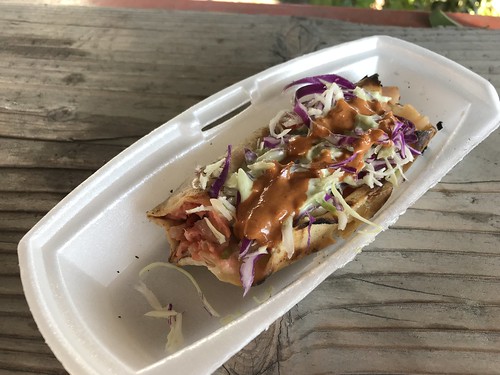
The next stop was a food truck well known among locals and had a small crowd. We got fish tacos that took a while to prepare, but were outstanding. I’ve never had anything quite like it — the soft shell tacos were crunchy and grilled on the outside, but soft on the inside.
This was by far the highlight of the tour for me. Fish tacos are a classic Californian dish, but this variation blew me away. The younger member of the New Jersey group confessed this was the best fish taco she’d ever had, and I couldn’t disagree.
On the way to the next stop one member of our group pointed out that the top of a fire hydrant seemed to be sticking out from the sidewalk. Albert brushed this off replying with “a lot of what you’ll see in Mexico makes no sense.” Words to live by.
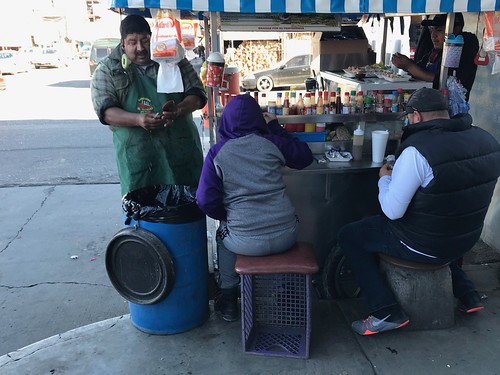
Next we wandered over to a street food vendor offering a variety of seafood dishes. We got their ceviche, which was good though it seemed like a step down from the previous tacos. Then again almost anything would seem like a step down from those delicious tacos.
Some of the other seafood dishes they offered seemed more interesting, including a raw clam dish. One person in the group wanted to try it, but our guide warned them it would be very filling and spoil their appetite for the rest of the tour.
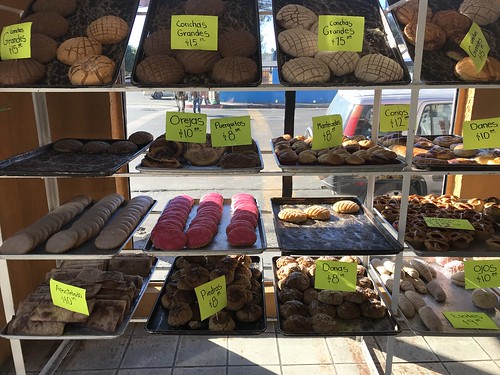
Although not part of the tour exactly, we went to a traditional Mexican bakery for those interested in purchasing classic Mexican sweet pastries and cookies. Apparently California’s food import laws allow baked goods to be brought in. They’re much pickier about fruits, however. But fruits in baked goods are okay.
We made a brief stop at a corner taco stand serving carne asada tacos. As a pescatarian I had a bean taco which was fine, especially after adding various toppings including extremely spicy salsa and grilled onions. The best part was the tortilla, handmade to order right there at the taco stand as we watched.
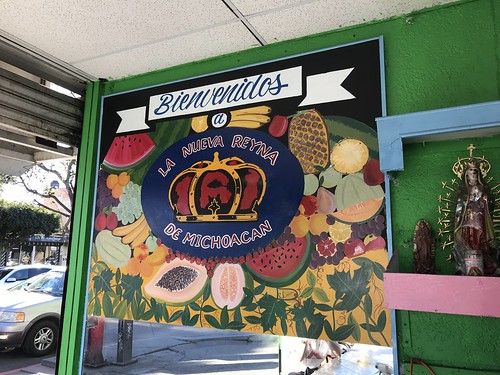
We had a much longer stop at an indoor juice shop for agua frescas and horchata. The owner’s daughter served the beverages for us, she was barely tall enough to reach over the refrigerators. My horchata was excellent. Aside from the bakery this was the only stop that I guess isn’t technically street food, though the sides of the store were open to the sidewalk.
This stop offered a nice chance to sit at some makeshift tables and chairs and chat for a bit while watching the people, cars, and taxi buses pass by. Albert told us about some of the other tours he offers, including one to Caesars, the Tijuana restaurant that invented the Caesar salad. The guy gets around, he says he’s going to have some completely new food tours just days away in 2019.
As we sat at the corner juice spot one person in the group pointed out how Mexico’s stoplights work differently — before switching to yellow, the green light starts flashing. At the same time the walk signal starts flashing as well, before switching to a solid red hand.
I’d noticed this as well. Some of the pedestrian signals have countdown timers, but they often aren’t hooked up correctly. (Many just flash “88.”) This hardly matters since Mexican drivers treat stop lights as suggestions rather than rules so you have to be careful and cross your fingers as you cross the street.
The father of the New Zealander in the group told me he thought California drivers were overly polite and was more used to haphazard way people drive in Mexico. He claimed it’s due to some weird quirk in New Zealand’s law where car insurance is partially government subsidized so there’s less personal incentive to avoid collisions.
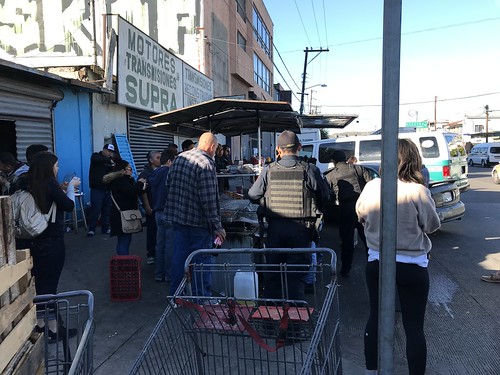
Our last major food break was another taco stand, a big street food operation that attracted quite a crowd. At this point I was super stuffed and could only finish off one of the two fried fish and seasoned sour cream tacos. Two police officers were taking their time at their lunch break as we ate. They hogged the salsa stand perched on an outdoor windowsill.
Strangely this street food stand had a storefront across the sidewalk they used for storing ingredients and such. Seemed to me they could have just operated out of there? Then again they were clearly successful operating just off the sidewalk so who am I to argue.
Aside from fish tacos this vendor also specialized in a seafood soup. That might have been a better option at this spot but it was interesting watching the guy operating the fryer, tossing breaded fish into a huge vat of oil for the fried fish tacos.
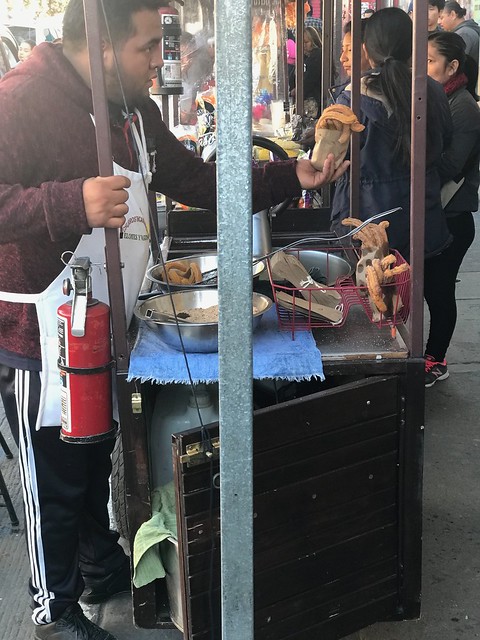
The last food stop crossed the ultra-touristy Avenida Revolucion to a vendor offering churros. Don’t get me wrong, a freshly fried churro is great; but it also seemed anti-climactic for a food tour. Then again I was far more used to Mexican food than most of the participants in the group, being the only Californian.
The vendor made each churro by extruding the dough from a device built into the cart by cranking what looked like a steering wheel before dipping it in the fryer. These were very small, thin churros sold in a small paper bag like french fries. And I have to say they were delicious.
On the opposite side of the sidewalk a store was selling shoes… and mobile phones. Only in Mexico!
At the end Albert took us on a on a shared taxi back to the border and instructed us where to go. He said he’d stay the night in Tijuana as we all passed customs back into the US.
Entering the US on foot from Tijuana was very quick. There was no special line for US citizens. One of the New Zealanders made it across before I did, and we wished one another a happy new year before I had to literally run to catch the Blue Line trolley back to downtown San Diego.
